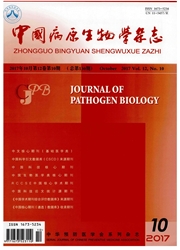

 中文摘要:
中文摘要:
目的鉴定家兔感染隐孢子虫种类,收集兔隐孢子虫卵囊。方法采用饱和蔗糖溶液漂浮法检查郑州市郊区某兔场兔新鲜粪便标本中的隐孢子虫卵囊;基于18SrRNA基因位点对隐孢子虫阳性标本进行序列分析。结果 87份标本中10份隐孢子虫阳性。经序列比对分析,10个分离株均为兔隐孢子虫。用隐孢子虫卵囊接种4只30d龄无球虫仔兔(1×10^4个卵囊/只),潜隐期为3d,显露期为10d,于感染后第6d和第9d出现两个排卵囊高峰期。结论家兔分离株隐孢子虫为兔隐孢子虫(Cryptosporidium cuniculus),感染仔兔后获得到大量纯卵囊。
 英文摘要:
英文摘要:
Objectives To identify species of Cryptosporidium isolates from domestic rabbits and collect the oocysts of Cryptosporidium cuniculus. Methods Fresh fecal samples were collected from a rabbit farm in Zhengzhou and Cryptosporidium was detected using Sbeather's sugar flotation technique. Cryptosporidium-positive samples were analyzed by DNA sequencing of the small subunit rRNA gene. Results Of 87 fecal samples, 10 were Cryptosporidium-positive, and sequencing showed that the 10 Cryptosporidium isolates were all C. cuniculus. After collection of C. cuniculus oo cysts, four 30 day-old rabbits were inoculated with 1 ×10^4 oocysts each. The latent period and the patent period were 4 days and 24 days, respectively. Two oocyst shedding peaks were noted at 6 PID and 9 PID. Conclusion Cryptosporidium species in rabbit isolates were C. cuniculus, and a large number of C. cuniculus oocysts were obtained by infecting rabbits.
 同期刊论文项目
同期刊论文项目
 同项目期刊论文
同项目期刊论文
 期刊信息
期刊信息
